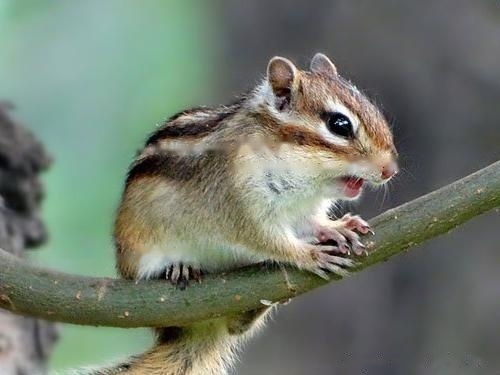Chipmunks have two elastic pockets inside their cheeks - cheek pockets. The cheek pockets are large enough to hold up to seven acorns, and like carrying a lunch box with them, they can store food in the cheek pockets and take them out for a meal when they are hungry. Chipmunks are very clean animals, always grooming themselves. As winter approaches, fewer chipmunks forage under trees, spending more and more time in their burrows. So what are its living habits?

chipmunk
The chipmunk will spend five months of winter here, lying in a leafy nest on top of the food, waking up again and again to eat. Males emerge first in the spring, and they end hibernation about two weeks earlier than females. Temperatures are usually above freezing and there is little food around, so they must continue to rely on the food they have stockpiled from the previous summer and fall. Chipmunk breeding season is here, and the males are looking for mates. Chipmunks do not have strict territorial boundaries, and they often walk into neighbors' territory. Each chipmunk offends neighbors many times, which leads to high-speed chases in the woods. After mating is complete, the females drive the males away. After a month, the female mice will give birth to young mice in the ground.
The chipmunk loves to climb. In midsummer, the berries and seeds ripen on the tall branches. It leaves only the seeds, and very skillfully strips the rest of the fruit so that it comes back full.
Since the chipmunk disperses its seeds as widely as possible, it actually plays a meaningful and extremely important role in forest ecology in nature. Doing so will also benefit the offspring of chipmunks.
Breeding temperature
Small squirrels that are less than two months old before the beginning of June need to keep warm at night. Especially in the temperature in the north, if the temperature is too low, it is easy to catch a cold. At night, you should add a little more cushion material to them, change the cushion material in the morning, and pay attention to the ventilation during the day. After the end of June, mice need to pay attention to heatstroke prevention and cooling during the day. Heatstroke caused by too high temperature is also fatal to squirrels. You can keep indoor air circulation, put a few bottles of cold water in the cage during the day, put a tile, etc., if he feels too hot, he will lie down on it to cool down, all of which can prevent high temperature heatstroke.
![[Dog Training 5] The training method of pet dog dining etiquette](/static/img/12192/12192_1.jpg)




